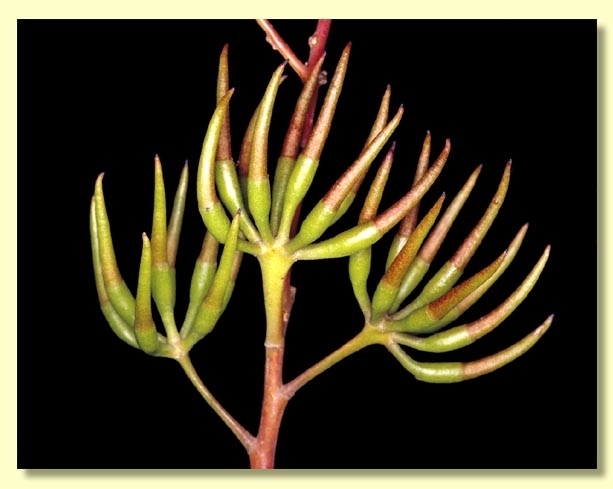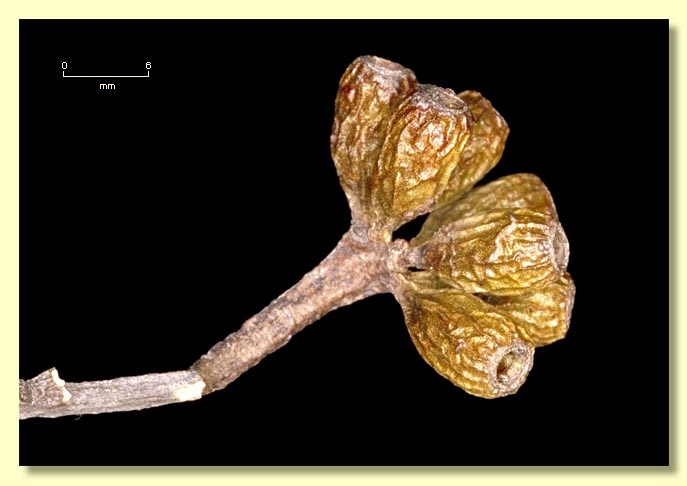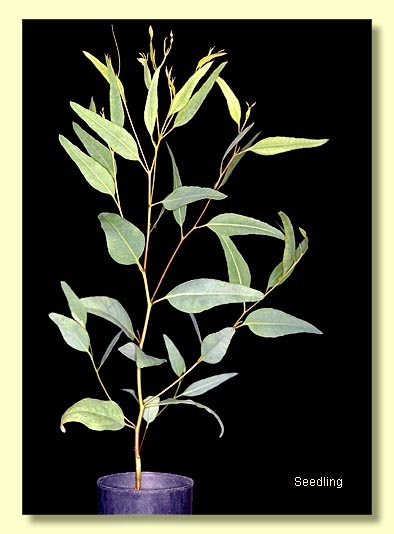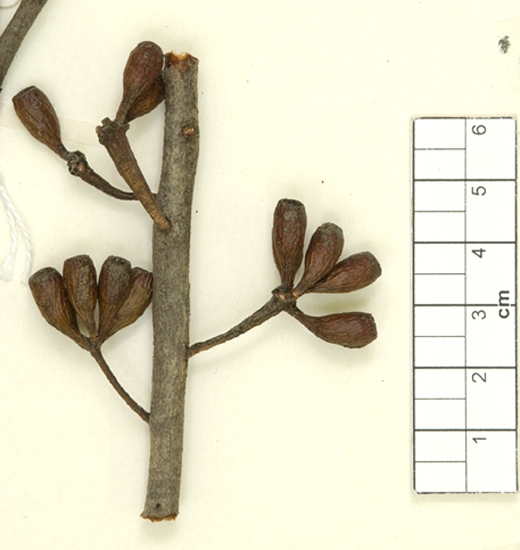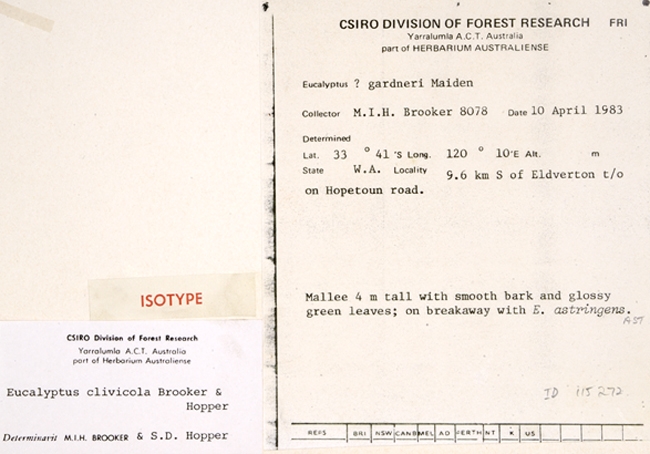Euclid - Online edition
Eucalyptus clivicola
Eucalyptus | Symphyomyrtus | Bisectae | Glandulosae | Levispermae | Phaenophylla
Bark smooth throughout, dark and whitish grey over brownish, or mottled with imperfectly shed flakes of brown-grey rough bark.
Branchlets with oil glands in the pith, rarely glands few and hard to find.
Juvenile growth (coppice or wild seedling to 50 cm tall): not seen.
Adult leaves alternate, petioles 0.5–1.5 cm long; blade linear to lanceolate, 4.5–9.5 cm long, 0.5–2 cm wide, base tapering to petiole, margin entire, apex pointed, concolorous, glossy, dark green, side-veins about 45° to midrib or more, reticulation dense, intramarginal vein more or less remote from margin, oil glands island and intersectional.
Inflorescence axillary unbranched, peduncles widening apically, 0.7–2 cm long, buds 9 to 13 per umbel, pedicels 0.4–0.5 cm long. Mature buds fusiform to very elongated (1.4–2.1 cm long, 0.3–0.4 cm wide), curved or straight, scar present, operculum conical to horn-shaped, twice to three times the length of the hypanthium and equal to it in width at the join, few outer stamens erect, most stamens variably deflexed, anthers oblong, versatile, dorsifixed, dehiscing by longitudinal slits, style long and straight, stigma tapered, locules 3, the placentae each with 4 vertical rows of ovules. Flowers pale yellow.
Fruit pedicellate (pedicels 0.3–0.6 cm long), barrel-shaped to obconical or cylindrical, 0.6–1 cm long, 0.5–0.6 cm wide, disc descending vertically, valves 3, about rim level.
Seeds straw-coloured, 0.7–1.5 mm long, sub-spherical, surface smooth, hilum ventral/terminal.
Cultivated seedlings (measured at ca node 10): cotyledons Y-shaped (bisected); stems rounded to obscurely triangular in cross-section; leaves petiolate, opposite for ca 2 to 4 nodes then alternate, ovate to lanceolate, 5–9 cm long, 1–3 cm wide, dull, slightly bluish green becoming green and slightly glossy by ca node 9–10.
Flowering has been recorded in February, March and April.
A mallet endemic to Western Australia, of southern coastal and subcoastal areas from Borden in the west to Fitzgerald River National Park and the Ravensthorpe Range, usually occurring on lateritic ridges or slopes. The bark is smooth, grey to silvery or coppery, often with unshed flakes. The adult leaves are glossy green and buds elongated (fusiform), and very elongated buds.
Eucalyptus clivicola belongs to Eucalyptus subgenus Symphyomyrtus section Bisectae subsection Glandulosae because the cotyledons are bisected, buds have an operculum scar and the branchlets have oil glands in the pith. Within this subsection E. clivicola is one of a group of species that form series Levispermae subseries Phaenophylla characterised by having smooth sub-spherical seed, buds that are narrowly fusiform with some stamens erect and others variably deflexed, and glossy green adult leaves.
E. clivicola is distinguished by the combination of smooth bark, mallet habit, glossy green adult leaves and narrowly fusiform buds to 2.1 cm long that have the operculum equal in width to the hypanthium at the join. Other mallet species in this group are E. arachnaea subsp. arrecta, which differs in having a dark rough-barked trunk, buds with an operculum that is narrower than the hypanthium at the join and also is curved apically and a much more northerly distribution (only around Morowa); E. praetermissa and E. melanophitra, both of which have dull green leaves and slightly shorter buds, at least some rough bark and occur in the Beaufort Inlet – Boxwood Hill area; and two dull blue to grey-leaved species, E. densa subsp. densa and E. gardneri subsp. gardneri.




